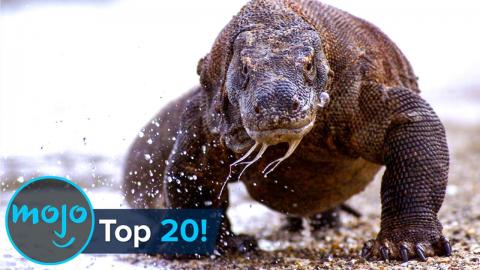Top 20 Greatest Animal Predators

Top 20 Animal Predators
Top 10 Stories Behind Hollywood's Greatest Animal Stars
In the animal kingdom, you're either the hunter, or the hunted. Welcome to WatchMojo, and today we're counting down our picks for the Top 20 Animal Predators. For this list, we'll be ranking the most deadly or efficient predators from the animal kingdom. Land, sea and air will all be considered, so long as the creatures in question are known for possessing deadly skill and ability in the wild.
#20: Scorpion
Top 10 Songs from Drake's Scorpion
Not every animal predator needs to be a threat to humanity. The venom contained within a scorpion's stinger is certainly deadly to their natural prey, hence their appearance on our list, but only certain species of this arachnid possess the potential to be lethal towards people. Scorpions actually prefer to attack their prey directly, if they can, utilizing venom to pacify or paralyze other creatures if they can't kill them with their pincers. This venom is also a natural defense against other predators, making the scorpion an effective and fascinating animal predator.
#19: Owl
Top 24 Greatest Sports Moments of Each Year (2000 - 2023)
Owls have a reputation of being wise, but they're also wily hunters, utilizing every tool at their disposal to hunt their prey. These beautiful birds are farsighted, but their nighttime eyesight is more than adept enough to spot small mice, insects, other birds or even fish. Meanwhile, owls can quietly fly through the night and use their sharp talons to cut and crush during an attack, while their curved beak eliminates excess noise and sound from interfering with their feeding schedule. Finally, the owls natural down can often help them blend into their surroundings, meaning that by the time their prey sees the owl leave their perch, it's already too late.
#18: Cougar
Don't blink. Don't breathe. What's that lurking in the brush? Cougars love to stalk their prey and attack when least expected, sometimes even breaking the necks of smaller animals with a single pounce. These otherwise gorgeous great cats are generally solo hunters, keeping to themselves and ambushing prey when they need to feed. Deer are the cougar's favorite meal, with attacks on humans being the exception rather than the rule. Don't play dead with this big cat, however, because the cougar can be opportunistic and take a chance on an easy meal if provoked or cornered.
#17: Komodo Dragon
It's not wise to mess with a komodo dragon. It's the largest living species of lizard in the world today, with some possessing the potential to grow up to ten feet long. This beast doesn't differentiate much when it comes to prey, either, attacking animals from land, sea and air. Not even humans are safe from the komodo dragon, as they've been known to attack people with their swift movements and sharp jaws. This is usually only if provoked, however, as the komodo dragon usually prefers to dine on carrion or prey it can surprise and kill quickly with a rip, a tear or a slash with their sharp, dangerous claws.
#16: Hyena
There are many popular conceptions about how hyenas are supposed to act, with some of the animal's stereotypically skittish behavior remaining intact for certain, select hyena species. Other varieties, specifically the spotted hyena can be forthright and vicious predators, moving in swift packs to give chase to their prey, eventually tiring them out and pouncing when at the point of exhaustion. Both spotted and striped hyena have been known to attack people, however, with the young, infirm or injured serving as favorite targets for hyena looking for an easy meal. So yeah, these beasts may be opportunistic hunters, but that doesn't make them any less dangerous.
#15: Barracuda
The last thing you'll want to say when you see one of these bad boys is “oooo, barracuda”. At least not in a jolly tone. These underwater killers move swiftly and strike with incredible force, often severing their prey in half with their powerful jaws and sharp teeth. They have no qualms about swimming straight into a school of fish when in search of dinner, although attacks on humans tend to be fairly rare. This isn't to say that you should by any means agitate a barracuda if you're out deep sea diving or on vacation, as they WILL attack if provoked, but in general barracuda tend to stay in their lane.
#14: Bobcat
The bobcat is somewhat unique on our list, in that its diet and hunting schedule can vary, depending on available prey in their area. This large cat doesn't require a steady diet of meat to thrive in the wild, and is known to prey upon smaller mammals, such as rabbits, when pickings are plentiful. At other times, there's no stopping a hungry bobcat from taking on larger animals like deer, in order to provide sustenance for the long duration. The bobcat even varies its hunting approach depending on the size of prey, utilizing a stalk-and-kill method for big animals, and a wait-and-pounce approach for smaller, easier to kill hares or rodents.
#13: Brown Recluse Spider
Cyntoia Brown Case: Top 5 Facts You Need to Know
Those with arachnophobia take note, our next entry might trigger some... let's say "adverse" reactions. Spider bites aren't usually a source of immediate worry, but that's definitely NOT the case when it comes to the brown recluse spider, as its venom can develop painful ulcers or even sickness upon an untreated human victim. Thankfully, these little buggers don't tend to bother humans unless disturbed, but that doesn't mean the brown recluse spider is a saint, because they're actually accomplished hunters. Larger insects are sometimes caught in the spider's web, but the brown recluse is also one of the few species that also ventures out at night to actively hunt for prey, paralyzing them with their bite and eating them alive.
#12: Black Mamba
Do Black Holes Die? | Unveiled
So, you're not scared of spiders, eh? Well about how snakes, Dr. Jones? The black mamba is a deadly serpentine killer that moves fast, strikes faster and possesses a lethal venom that can be fatal if not immediately treated. Humans don't necessarily need to fear the black mamba unless they provoke or accidentally stumble upon one in the wild, but this snake is still quite aggressive, hunting small mammals from its lair with great success. In fact, only large birds, such as the eagle, serve as one of the black mamba's natural predators, making this killer serpent a perfect choice for Quentin Tarantino when he was looking to name his character of Beatrix "The Bride" Kiddo for his "Kill Bill" franchise.
#11: Wolverine
Wolverine Returns?! Chris Pratt Fires Back! James Cameron Abandons Avatar? Stranger Things S5 News!
Why hunt if you don't have to? Wolverines certainly don't seem to stress it too much, as they're more than physically able to survive in the wild. These small and stocky cousins to the badger and possum often scavenge for food, taking advantage of the scraps left behind by other predators. Then again, wolverines are also capable of taking on larger animals, such as deer or moose, utilizing instinct and environment to attack prey that have been disabled by the cold and snowy climates in which they tend to live. Wolverines are strong and fierce predators, often standing their ground against natural enemies like wolves, thanks to their thick skin and coat, which serves as natural protection from elements and attack.
#10: Anaconda
This deadly species of snake is most often found in South America, where it exists as a top-level predator, thanks to its immense size and formidable strength. Although the term “anaconda” can describe multiple members of the species, it’s most commonly used in reference to the green anaconda, which is the heaviest and second longest snake in the world. Anacondas commonly use their extreme length to wrap around their prey, crushing their bones, eliminating oxygen intake and overall just making any enemy or food target have a pretty terrible time. And they have been known to eat other anacondas.
#9: Eagle
If the lion is considered the King of the Jungle, then the eagle is its avian counterpart, an apex predator of the skies. This strong and agile bird of prey possesses nearly all of the skills necessary to make easy meat out of just about any smaller species on the ground, thanks to its keen eyesight, immense speed and sharp, deadly talons. Second only to vultures in size - especially the largest eagle species, the Philippine Eagle - these Kings of the Sky make quick work of just about anything they spot.
#8: Crocodile
These killers may be cold blooded, but they like the heat of the tropics. Dwelling primarily within smaller bodies of water, such as rivers, lakes and streams they feed on a steady diet of smaller fish and crustaceans. The crocodile is only one of several species of freshwater reptiles from a family that includes the alligator and gharial, a species most often found in India. How do you tell them apart? Crocs tend to possess a sharp “V” shape snout, as opposed to the “U” formation of an alligator. One thing’s for sure, however: you do NOT want to wind up caught up in that mouth. Those unforgiving teeth and tightly clenched jaws are enough to kill just about anything and anyone.
#7: Cheetah
Don’t even try to outrun this feline predator; it just ain’t gonna happen. Indeed, what the cheetah lacks in comparative size and strength to its big cat cousins, it more than makes up for in breakneck speed. The cheetah uses its lean, muscular physique and powerful legs to race and overtake its prey, particularly packs of antelope or gazelle, with relative ease and vicious results. Add to this the fact that cheetahs can also stop on a dime, change direction and accelerate rapidly, and you have yourself a whole new, deadly spin on fast food.
#6: Great White Shark
Alexander the Great vs. Julius Caesar
One look at the great white shark is enough to send just about anybody swimming for his or her life. Sure, predatory sharks on their own are bad news enough for smaller fish in the sea, but the great white is the badass of them all. This guy has no natural predators other than the killer whale, making it one hell of a tough customer. Fast, strong and relentless in its quest to feed, there’s a reason why the great white shark has haunted the dreams of so many moviegoers since “Jaws” first hit the screen in 1975. They continue to be cinematic fodder to this day.
#5: Lion
Known as the King of the Jungle, the proud and mighty lion is a big cat that also happens to be one of nature’s supreme predators. Although tigers are often larger in stature, the lion’s regal reputation and fiercely protective family structure make them dangerous opponents for even the heartiest of wild felines. Massive jaws, sharp claws and the lion’s taut hind legs make them a four-footed killing machine for just about anything that crosses their paths. The average lifespan of a lion rarely exceeds fifteen years, however, thanks in part to territorial squabbles with other cats, not to mention hunting threats from humans.
#4: Grizzly Bear
If the Academy Award-winning film “The Revenant” has taught us anything, it’s that one should NEVER antagonize a bear or its cubs. This fact is true no matter which species of bear one happens to encounter, whether it’s the North American black bear, the Arctic polar bear, or this entry’s animal predator, the mighty grizzly bear. Sure, grizzlies may look cute and cuddly when they’re NOT mauling prey or otherwise being terrifying, but watch out. This subspecies of brown bear has multiple means of getting one over on its dinner, including sharp claws, strong teeth and their massive physical frame. Grizzly bears are also damn quick, too, so if you’re thinking of running away or climbing a tree, don’t.
#3: Gray Wolf
A pack of wolves on one’s tail is not the most fortunate of situations, and it’s exponentially worse should that pack be composed of North American gray wolves. This species of wild canid is one of the largest in the world, while also one of the most unique, thanks to a number of interesting personality traits. For one, the gray wolf is monogamous, often mating for life. They hunt in a fairly large pack formation, often containing the parents and offspring together in one unit. Gray wolves also tend to be quite communicative between each other, utilizing facial and bodily cues in a fashion that makes them one of the most distinctly visual predators on our list.
#2: Tiger
Did Aliens Cause the Tiger Stripes on Enceladus? | Unveiled
This big cat is the largest species of feline in the world, combining strength and lean speed to make one of the animal kingdom’s most dangerous apex predators. Although lions often travel in large, social packs, the tiger is a bit more reserved and shy. Still, their tendency to live within close proximity to humans has resulted in unfortunate clashes over the years. Tigers generally hunt at night, and aren’t above attacking other, similarly sized predators for food sources, showing little to no fear of just about anything or anyone. So, you would think something like a lion or tiger or bear would top this list, right? Or maybe even a shark. But we’ve seen all those! So what could it be? Well, I will give you this clue: it’s got “killer” right in its name. So let’s look at some dangerous HMs and then we’ll crown our pick for top animal predator Before we name our number one pick, here are some honorable mentions! Honey Badger Fox Leopard Seal Box Jellyfish
#1: Killer Whale [aka Orca]
Top 10 Unsolved Serial Killer Mysteries
The great white shark only has one natural predator, and it’s this one: the orca, which is also called the killer whale. So, how does it feel to be the only creature fearsome enough to punish a great white? We’re just going to assume that it feels pretty damn good. And why not? These massive oceanic predators have no natural enemies, placing them squarely at the top of their food chain. Killer whales have been known to snack on all manner of fish, big and small, and possess the strength, agility and chomping jaws to get the job done. Fortunately, they rarely, if ever pose an immediate threat to humans.... even if the 1977 “animal attack” flick “Orca: The Killer Whale” demonstrated otherwise!










